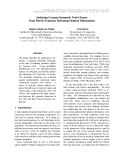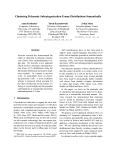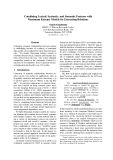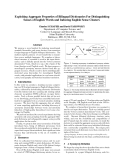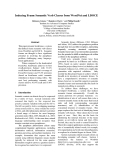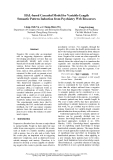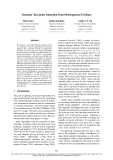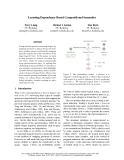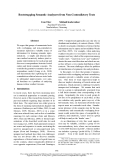
Inducing a semantically
-
We introduce two Bayesian models for unsupervised semantic role labeling (SRL) task. The models treat SRL as clustering of syntactic signatures of arguments with clusters corresponding to semantic roles. The first model induces these clusterings independently for each predicate, exploiting the Chinese Restaurant Process (CRP) as a prior. In a more refined hierarchical model, we inject the intuition that the clusterings are similar across different predicates, even though they are not necessarily identical.
 11p
11p  bunthai_1
bunthai_1
 06-05-2013
06-05-2013
 44
44
 3
3
 Download
Download
-
The paper describes the application of kMeans, a standard clustering technique, to the task of inducing semantic classes for German verbs. Using probability distributions over verb subcategorisation frames, we obtained an intuitively plausible clustering of 57 verbs into 14 classes. The automatic clustering was evaluated against independently motivated, handconstructed semantic verb classes.
 8p
8p  bunmoc_1
bunmoc_1
 20-04-2013
20-04-2013
 28
28
 1
1
 Download
Download
-
We present a technique for automatic induction of slot annotations for subcategorization frames, based on induction of hidden classes in the EM framework of statistical estimation. The models are empirically evalutated by a general decision test. Induction of slot labeling for subcategorization frames is accomplished by a further application of EM, and applied experimentally on frame observations derived from parsing large corpora. We outline an interpretation of the learned representations as theoretical-linguistic decompositional lexical entries. ...
 8p
8p  bunrieu_1
bunrieu_1
 18-04-2013
18-04-2013
 42
42
 3
3
 Download
Download
-
Previous research has demonstrated the utility of clustering in inducing semantic verb classes from undisambiguated corpus data. We describe a new approach which involves clustering subcategorization frame (SCF) distributions using the Information Bottleneck and nearest neighbour methods. In contrast to previous work, we particularly focus on clustering polysemic verbs. A novel evaluation scheme is proposed which accounts for the effect of polysemy on the clusters, offering us a good insight into the potential and limitations of semantically classifying undisambiguated SCF data. ...
 8p
8p  bunbo_1
bunbo_1
 17-04-2013
17-04-2013
 39
39
 2
2
 Download
Download
-
Recent studies in word sense induction are based on clustering global co-occurrence vectors, i.e. vectors that reflect the overall behavior of a word in a corpus. If a word is semantically ambiguous, this means that these vectors are mixtures of all its senses. Inducing a word’s senses therefore involves the difficult problem of recovering the sense vectors from the mixtures.
 4p
4p  bunbo_1
bunbo_1
 17-04-2013
17-04-2013
 32
32
 2
2
 Download
Download
-
Extracting semantic relationships between entities is challenging because of a paucity of annotated data and the errors induced by entity detection modules. We employ Maximum Entropy models to combine diverse lexical, syntactic and semantic features derived from the text. Our system obtained competitive results in the Automatic Content Extraction (ACE) evaluation. Here we present our general approach and describe our ACE results.
 4p
4p  bunbo_1
bunbo_1
 17-04-2013
17-04-2013
 49
49
 1
1
 Download
Download
-
We propose a novel method for inducing monolingual semantic hierarchies and sense clusters from numerous foreign-language-to-English bilingual dictionaries. The method exploits patterns of non-transitivity in translations across multiple languages. No complex or hierarchical structure is assumed or used in the input dictionaries: each is initially parsed into the “lowest common denominator” form, which is to say, a list of pairs of the form (foreign word, English word).
 4p
4p  bunbo_1
bunbo_1
 17-04-2013
17-04-2013
 45
45
 1
1
 Download
Download
-
This paper presents SemFrame, a system that induces frame semantic verb classes from WordNet and LDOCE. Semantic frames are thought to have significant potential in resolving the paraphrase problem challenging many languagebased applications. When compared to the handcrafted FrameNet, SemFrame achieves its best recall-precision balance with 83.2% recall (based on SemFrame's coverage of FrameNet frames) and 73.8% precision (based on SemFrame verbs’ semantic relatedness to frame-evoking verbs). The next best performing semantic verb classes achieve 56.9% recall and 55.0% precision. ...
 8p
8p  bunbo_1
bunbo_1
 17-04-2013
17-04-2013
 41
41
 1
1
 Download
Download
-
The EM clustering algorithm (Hofmann and Puzicha, 1998) used here is an unsupervised machine learning algorithm that has been applied in many NLP tasks, such as inducing a semantically labeled lexicon and determining lexical choice in machine translation (Rooth et al., 1998), automatic acquisition of verb semantic classes (Schulte im Walde, 2000) and automatic semantic labeling (Gildea and Jurafsky, 2002).
 8p
8p  bunbo_1
bunbo_1
 17-04-2013
17-04-2013
 41
41
 1
1
 Download
Download
-
In this paper, we present an unsupervised methodology for propagating lexical cooccurrence vectors into an ontology such as WordNet. We evaluate the framework on the task of automatically attaching new concepts into the ontology. Experimental results show 73.9% attachment accuracy in the first position and 81.3% accuracy in the top-5 positions. This framework could potentially serve as a foundation for ontologizing lexical-semantic resources and assist the development of other largescale and internally consistent collections of semantic information. ...
 8p
8p  bunbo_1
bunbo_1
 17-04-2013
17-04-2013
 44
44
 2
2
 Download
Download
-
This paper examines whether a learningbased coreference resolver can be improved using semantic class knowledge that is automatically acquired from a version of the Penn Treebank in which the noun phrases are labeled with their semantic classes. Experiments on the ACE test data show that a resolver that employs such induced semantic class knowledge yields a statistically significant improvement of 2% in F-measure over one that exploits heuristically computed semantic class knowledge. In addition, the induced knowledge improves the accuracy of common noun resolution by 2-6%. ...
 8p
8p  hongvang_1
hongvang_1
 16-04-2013
16-04-2013
 40
40
 1
1
 Download
Download
-
Negative life events play an important role in triggering depressive episodes. Developing psychiatric services that can automatically identify such events is beneficial for mental health care and prevention. Before these services can be provided, some meaningful semantic patterns, such as , have to be extracted. In this work, we present a text mining framework capable of inducing variable-length semantic patterns from unannotated psychiatry web resources.
 8p
8p  hongvang_1
hongvang_1
 16-04-2013
16-04-2013
 53
53
 1
1
 Download
Download
-
We propose a novel algorithm for inducing semantic taxonomies. Previous algorithms for taxonomy induction have typically focused on independent classifiers for discovering new single relationships based on hand-constructed or automatically discovered textual patterns. By contrast, our algorithm flexibly incorporates evidence from multiple classifiers over heterogenous relationships to optimize the entire structure of the taxonomy, using knowledge of a word’s coordinate terms to help in determining its hypernyms, and vice versa. ...
 8p
8p  hongvang_1
hongvang_1
 16-04-2013
16-04-2013
 46
46
 2
2
 Download
Download
-
We propose using large-scale clustering of dependency relations between verbs and multiword nouns (MNs) to construct a gazetteer for named entity recognition (NER). Since dependency relations capture the semantics of MNs well, the MN clusters constructed by using dependency relations should serve as a good gazetteer. However, the high level of computational cost has prevented the use of clustering for constructing gazetteers.
 9p
9p  hongphan_1
hongphan_1
 15-04-2013
15-04-2013
 46
46
 1
1
 Download
Download
-
Compositional question answering begins by mapping questions to logical forms, but training a semantic parser to perform this mapping typically requires the costly annotation of the target logical forms. In this paper, we learn to map questions to answers via latent logical forms, which are induced automatically from question-answer pairs. In tackling this challenging learning problem, we introduce a new semantic representation which highlights a parallel between dependency syntax and efficient evaluation of logical forms. ...
 10p
10p  hongdo_1
hongdo_1
 12-04-2013
12-04-2013
 52
52
 4
4
 Download
Download
-
We argue that groups of unannotated texts with overlapping and non-contradictory semantics represent a valuable source of information for learning semantic representations. A simple and efficient inference method recursively induces joint semantic representations for each group and discovers correspondence between lexical entries and latent semantic concepts. We consider the generative semantics-text correspondence model (Liang et al.
 10p
10p  hongdo_1
hongdo_1
 12-04-2013
12-04-2013
 37
37
 1
1
 Download
Download
-
This research explores the idea of inducing domain-specific semantic class taggers using only a domain-specific text collection and seed words. The learning process begins by inducing a classifier that only has access to contextual features, forcing it to generalize beyond the seeds. The contextual classifier then labels new instances, to expand and diversify the training set. Next, a cross-category bootstrapping process simultaneously trains a suite of classifiers for multiple semantic classes. ...
 11p
11p  hongdo_1
hongdo_1
 12-04-2013
12-04-2013
 44
44
 1
1
 Download
Download
CHỦ ĐỀ BẠN MUỐN TÌM










